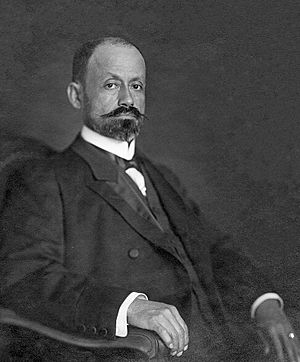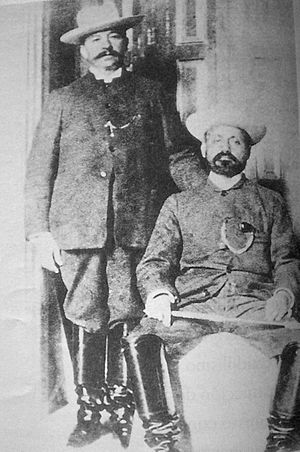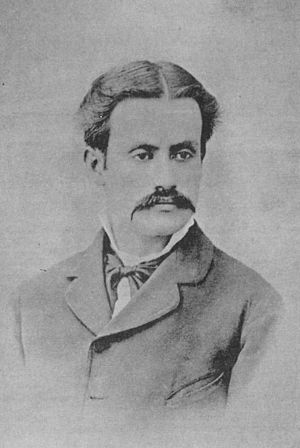Cipriano Castro facts for kids
Quick facts for kids
Cipriano Castro
|
|
|---|---|

Castro in 1908
|
|
| President of Venezuela | |
| In office 20 October 1899 – 19 December 1908 |
|
| Preceded by | Ignacio Andrade |
| Succeeded by | Juan Vicente Gómez |
| Personal details | |
| Born | 12 October 1858 Capacho Viejo, Táchira, Venezuela |
| Died | 4 December 1924 (aged 66) San Juan, Puerto Rico |
| Resting place | National Pantheon of Venezuela |
| Spouse | Zoila Rosa Martínez |
| Signature |  |
José Cipriano Castro Ruiz (born October 12, 1858 – died December 4, 1924) was an important officer in the Venezuelan military. He was also a politician who served as the president of Venezuela from 1899 to 1908. He was the first leader from the Venezuelan Andes mountains to rule the country. He was also the first of four strong military leaders from the state of Táchira to govern Venezuela over the next 46 years.
Contents
Early Life of Cipriano Castro
Cipriano Castro was born on October 12, 1858, in a place called Capacho Viejo in Táchira. His parents were José Carmen Castro and Pelagia Ruiz. His father was a farmer who owned a medium-sized farm. Cipriano received an education typical for middle-class families in his region.
His family had strong business and family ties with Colombia, especially with the cities of Cúcuta and Puerto Santander. After studying in his hometown and in San Cristóbal, he went to a seminary school in Pamplona, Colombia from 1872 to 1873. He later left his studies and returned to San Cristóbal. There, he worked for a company called Van Dissel, Thies and Ci'a. He also spent some time working as a cowboy in the Andean mountains.
Cipriano grew up in a large family with 22 brothers and sisters. His mother passed away, and his father remarried, which led to even more siblings. He was very close to his family. He even sent most of his younger brothers to study in Caracas.
How Castro Joined the Military and Politics
In 1876, Castro disagreed with General Francisco Alvarado, who wanted to become president of the Táchira state. In 1878, he was managing a newspaper called El Álbum. He joined a group of people who wanted independence and took over San Cristóbal. They refused to accept the new state president's authority.
In 1884, Castro had a disagreement with a local priest, Juan Ramón Cárdenas, in Capacho. This led to him being put in prison in San Cristóbal. After six months, he escaped and found safety in Cúcuta, Colombia. There, he ran a small inn. It was in Cúcuta that he met his future wife, Rosa Zoila Martínez, who became known as Doña Zoila.
In June 1886, he returned to Táchira as a soldier. He joined generals Segundo Prato, Buenaventura Macabeo Maldonado, and Carlos Rangel Garbiras. They wanted to fight for more local control, which the governor of Táchira, General Espíritu Santo Morales, did not like. Castro's forces won against government troops in Capacho Viejo and Rubio. He was promoted to general and became an important figure in Táchira's local politics.
During the burial of a fellow fighter, Evaristo Jaimes, Castro met Juan Vicente Gómez. Gómez would later become his close partner in gaining power. Castro entered politics and became the governor of Táchira. However, he was forced to leave Venezuela and live in Colombia when the government in Caracas was overthrown in 1892. Castro lived in Colombia for seven years. During this time, he gained resources and built a group of supporters.
Cipriano Castro's Presidency

Castro gathered a lot of support from unhappy Venezuelans. His personal group of supporters grew into a strong national army. In October 1899, he used this army to march on Caracas in an event called the Restorative Liberal Revolution. He took control and became the supreme military commander.
Once in power, Castro became president. He changed the constitution in 1904. He remained president from 1899 to 1908. He named Juan Vicente Gómez, his close friend, as vice-president.
Castro's time as president was difficult. There were many rebellions against him. His opponents were often killed or forced to leave the country. Castro also spent a lot of money on himself. He also had many problems with other countries. His nine years in power are mostly known for causing several foreign countries to get involved in Venezuela's affairs. This included blockades and attacks by ships from the Netherlands, Britain, Germany, and Italy. These countries wanted Venezuela to pay back money owed to their citizens.
Venezuela's Crisis (1901–1903)
In 1901, a banker named Manuel Antonio Matos led a big military movement called the Liberating Revolution. Their goal was to remove Cipriano Castro's government. Castro had serious disagreements with foreign businesses that supported this revolution. These included companies like New York and Bermudez Company and Krupp. This led to a major war that shook the country. It almost caused Castro's government to fall.
On April 2, 1902, Dutch warships, the HNLMS Koningin Regentes and the HNLMS Utrecht, arrived in the Venezuelan port of La Guaira. This was because of growing tension between the Netherlands and Venezuela. The Venezuelan Navy had been stopping Dutch merchant ships. The presence of the Dutch warships helped prevent further actions.

In November 1902, Castro's own troops broke the Siege of La Victoria. This weakened the large network of revolutionary armies.
A few weeks later, Britain, Germany, and Italy started a naval blockade of Venezuela. This lasted for several months. They did this because Castro refused to pay foreign debts and damages suffered by European citizens during the recent revolution. Castro thought the Monroe Doctrine would stop the United States from allowing European military action. However, at that time, President Theodore Roosevelt's government saw the Doctrine as preventing Europe from taking land, not from intervening in other ways. Since the European countries promised not to take Venezuelan land, the U.S. allowed the blockade.
The blockade quickly stopped Venezuela's small navy. But Castro still refused to give in. Instead, he agreed to let an international group decide on some of the claims, which he had refused before. Germany initially disagreed with this.
When news reports around the world reacted negatively to events like the sinking of two Venezuelan ships and the bombing of the coast, the U.S. put pressure on all sides to find a solution. The U.S. also pointed to its naval fleet nearby in Puerto Rico, led by Admiral George Dewey. Since Castro would not back down, and with growing negative reactions from the British and American press, the blockading nations agreed to a compromise. They kept the blockade during talks about the details.
This led to an agreement signed in Washington on February 13, 1903. The blockade was lifted. Venezuela, represented by U.S. ambassador Herbert W. Bowen, agreed to use 30% of its customs duties to pay the claims. Later, a special court decided that the blockading powers should be paid first, before other nations. The U.S. worried this would encourage Europe to intervene again in the future. This event helped create the Roosevelt Corollary to the Monroe Doctrine. This new idea stated that the United States had the right to step in and "stabilize" the money matters of small countries in the Caribbean and Central America if they couldn't pay their international debts. This was to prevent European countries from intervening. The revolutionaries, who were already weakened, finally lost in July 1903 in the Battle of Ciudad Bolivar. After this, Matos decided to leave Venezuela and settled in Paris.
Dutch–Venezuelan Crisis (1908)

In 1908, a disagreement started between the Netherlands and President Castro's government. This was because Venezuela accused the Netherlands of helping refugees in Curaçao. Venezuela then sent the Dutch ambassador away. This caused the Netherlands to send three warships: a coastal battleship, the HNLMS Jacob van Heemskerck, and two protected cruisers, the HNLMS Gelderland and the HNLMS Friesland. The Dutch warships were ordered to stop any ship sailing under the Venezuelan flag.
On December 12, 1908, the Gelderland captured the Venezuelan gunboat Alix near Puerto Cabello. This ship and another, the 23 de Mayo, were held in the harbor of Willemstad. With their much stronger navy, the Dutch created a blockade around Venezuela's ports.
Castro's Downfall in 1908 and Later Life
On December 19, 1908, while Castro was away, Juan Vicente Gómez took power himself. This effectively ended the conflict with the Netherlands. A few days later, General Castro left for Berlin, supposedly for a surgery. After that, Castro faced problems from European countries. They were angry because of the policies he had used against them during his eight years as president.
Without enough money to plan an armed return, he went to Madrid. Then he recovered from his operation in Paris and in Santa Cruz de Tenerife. At the end of 1912, Castro wanted to spend some time in the United States. However, he was stopped by immigration officials at Ellis Island and forced to leave in February 1913. He finally settled with his wife in Puerto Rico in 1916. He was closely watched by spies sent by Juan Vicente Gómez, who was now the Venezuelan president.
Castro spent the rest of his life living away from Venezuela in Puerto Rico. He made several plans to return to power, but none of them worked. Cipriano Castro died on December 4, 1924, in Santurce, Puerto Rico.
Cipriano Castro's Government (1899–1908)
| Ministries | ||
|---|---|---|
| OFFICE | NAME | TERM |
| President | Cipriano Castro | 1899–1908 |
| Home Affairs | Juan Francisco Castillo | 1899–1900 |
| Rafael Cabrera Malo | 1900–1901 | |
| José Antonio Velutini | 1901–1902 | |
| Rafael López Baralt | 1902–1903 | |
| Leopoldo Baptista | 1903–1907 | |
| Julio Torres Cárdenas | 1907 | |
| Rafael López Baralt | 1907–1908 | |
| Outer Relations | Raimundo Andueza Palacio | 1899–1900 |
| Eduardo Blanco | 1900–1901 | |
| Jacinto Regino Pachano | 1901–1902 | |
| Diego Bautista Ferrer | 1902–1903 | |
| Alejandro Urbaneja | 1903 | |
| Gustavo Sanabria | 1903–1905 | |
| Alejandro Ibarra | 1905–1906 | |
| José de Jesús Paúl | 1906–1908 | |
| Finance | Ramón Tello Mendoza | 1899–1903 |
| José Cecilio De Castro | 1903–1906 | |
| Francisco de Sales Pérez | 1906 | |
| Gustavo Sanabria | 1906 | |
| Eduardo Celis | 1906–1907 | |
| Arnaldo Morales | 1906–1907 | |
| War and Navy | José Ignacio Pulido | 1899–1902 |
| Ramón Guerra | 1902–1903 | |
| José María García Gómez | 1903 | |
| Manuel Salvador Araujo | 1903–1904 | |
| Joaquín Garrido | 1904–1905 | |
| José María García Gómez | 1905–1906 | |
| Diego Bautista Ferrer | 1906 | |
| Manuel Salvador Araujo | 1906–1907 | |
| Diego Bautista Ferrer | 1907–1908 | |
| Development | José Manuel Hernández | 1899 |
| Celestino Peraza | 1899 | |
| Guillermo Tell Villegas Pulido | 1899–1900 | |
| Ramón Ayala | 1900–1901 | |
| Felipe Arocha Gallegos | 1901–1902 | |
| Arnaldo Morales | 1902–1903 | |
| José T. Arria | 1903 | |
| Rafael Garbiras Guzmán | 1903–1904 | |
| Arnaldo Morales | 1904–1905 | |
| Diego Bautista Ferrer | 1905–1906 | |
| Arístides Tellería | 1906 | |
| Arnaldo Morales | 1906 | |
| Jesús María Herrera Irigoyen | 1906–1908 | |
| Public Works | Victor Rodríguez | 1899 |
| Juan Otáñez Maucó | 1899–1902 | |
| Rafael María Carabaño | 1902–1903 | |
| Ricardo Castillo Chapellín | 1903 | |
| Alejandro Rivas Vásquez | 1903–1904 | |
| Ricardo Castillo Chapellín | 1904–1906 | |
| Luis Mata Illas | 1906 | |
| Juan Casanova | 1906–1908 | |
| Public Instruction | Manuel Clemente Urbaneja | 1899–1900 |
| Félix Quintero | 1900–1901 | |
| Tomás Garbiras | 1901–1902 | |
| Rafael Monserrate | 1902–1903 | |
| Eduardo Blanco | 1903–1905 | |
| Arnaldo Morales | 1905–1906 | |
| Enrique Siso | 1906 | |
| Carlos León | 1906 | |
| Eduardo Blanco | 1906 | |
| Laureano Villanueva | 1906–1907 | |
| José Antonio Baldó | 1907–1908 | |
| Secretary of Presidency | Celestino Peraza | 1899 |
| Julio Torres Cárdenas | 1899–1906 | |
| Lucio Baldó | 1906 | |
| José Rafael Revenga | 1906–1907 | |
| Rafael Gárbiras Guzmán | 1907–1908 | |
| Leopoldo Baptista | 1908 | |
Cipriano Castro's Family Life
Castro was married to Zoila Rosa Martínez. She served as the First Lady of Venezuela from 1899 to 1908. Castro's daughter was an actress in Hollywood silent movies named Rosa Castro Martínez. She used the stage name Lucille Mendez. She was married to the film director Ralph Ince. She passed away in August 1982 in Hollywood, California, USA.
Interesting Facts About Castro
During his time as president, a strong earthquake hit northern Venezuela in 1900. It was called the 1900 San Narciso earthquake. This earthquake caused a lot of damage in Miranda State and in the capital city, Caracas. Castro was woken up in the middle of the night by the earthquake. He jumped out of a window of the Yellow House, which was the official home of the president at the time. He broke his ankle in the process.
Because of the earthquake, he thought about moving the official presidential home to a building that was safer from earthquakes. This happened in 1904. He moved the Presidential House to Miraflores Palace, becoming its first resident.
See also
 In Spanish: Cipriano Castro para niños
In Spanish: Cipriano Castro para niños
- Presidents of Venezuela
- List of Venezuelans




